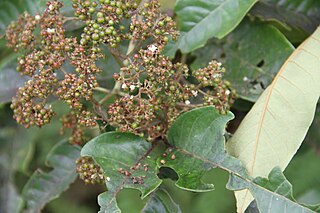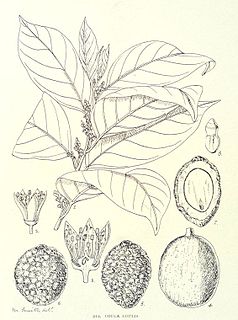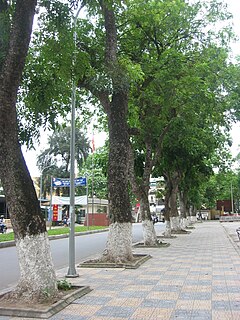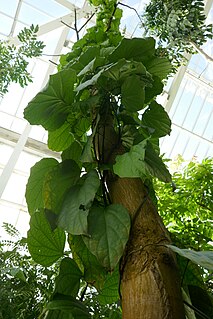
Sierra Leone, officially the Republic of Sierra Leone, informally Salone, is a country on the southwest coast of West Africa. It is bordered by Liberia to the southeast and Guinea to the northeast. Sierra Leone has a tropical climate with a diverse environment ranging from savanna to rainforests, a total area of 71,740 km2 (27,699 sq mi) and a population of 7,092,113 as of the 2015 census. The capital and largest city is Freetown. The country is divided into five administrative regions which are subdivided into sixteen districts. Sierra Leone is a constitutional republic with a unicameral parliament and a directly elected president. Sierra Leone is a Muslim majority country at approximately 78%, though with a politically influential Christian minority at about 21%. Muslims and Christians interact very well together and religious violence is extremely rare in the country. All the major Muslim and Christian holidays are officially national holidays in the country.
Polyglotta Africana is a study published in 1854 by the German missionary Sigismund Wilhelm Koelle (1823–1902), in which the author compares 280 words from 200 African languages and dialects. As a comparative study it was a major breakthrough at the time.
Oldfieldia is a plant genus under the family Picrodendraceae, the only member of its subtribe (Paiveusinae). It was described as a genus in 1850.

Harungana is a genus of flowering plants within the St. Johnswort family, Hypericaceae. It comprises only two species, Harungana madagascariensis and Harungana montana.

Coula edulis is a tree in the genus Coula, native to tropical western Africa from Sierra Leone to Angola. It is plentiful in the Democratic Republic of Congo, Nigeria and Sierra Leone. It prefers tropical regions and is tolerant of light shade. It can be found in the top canopy of forest as well as the lower story and has no special soil requirements.

Kigelia is a genus of flowering plants in the family Bignoniaceae. The genus consists of only one species, Kigelia africana, which occurs throughout tropical Africa. The so-called sausage tree grows a fruit that is up to 60 cm long, weighs about 7 kg, and resembles a sausage in a casing.

Prunus africana, the African cherry, has a wide distribution in Africa, occurring in montane regions of central and southern Africa and on the islands of Bioko, São-Tomé, Grande Comore, and Madagascar. It can be found at 900–3,400 m (3,000–10,000 ft) above sea level. It is a canopy tree 30–40 m in height, and is the tallest member of Prunus. Large-diameter trees have impressive, spreading crowns. It requires a moist climate, 900–3,400 mm (35–130 in) annual rainfall, and is moderately frost-tolerant. P. africana appears to be a light-demanding, secondary-forest species.

Voacanga africana is a small tree native to tropical Africa belonging to the family Apocynaceae that grows to 6 m (20 ft) in height and bears leaves that are up to 30 cm (12 in) in length. The yellow or white flowers are succeeded by paired, follicular, dehiscent fruit with a mottled green exocarp and a pulpy, yellow mesocarp surrounding the seeds. The plant contains alkaloids acting as CNS depressants and hypotensives

Afzelia africana, the African mahogany, afzelia, lenke, lengue, apa, or doussi, is a tree species in the family Fabaceae.

Khaya senegalensis is a species of tree in the Meliaceae family that is native to Africa. Common names include African mahogany, dry zone mahogany, Gambia mahogany, khaya wood, Senegal mahogany, cailcedrat, acajou, djalla, and bois rouge.
Turraeanthus africana is a species of plant in the family Meliaceae, also known by the common names avodiré, apeya, engan, agbe, lusamba, wansenwa, African satinwood, and African white mahogany.

The Guinean mangroves are a coastal ecoregion of mangrove swamps in rivers and estuaries near the ocean of West Africa from Senegal to Sierra Leone.

The Western African Ebola virus epidemic (2013–2016) was the most widespread outbreak of Ebola virus disease (EVD) in history, causing major loss of life and socioeconomic disruption in the region, mainly in Guinea, Liberia and Sierra Leone. The first cases were recorded in Guinea in December 2013; later, the disease spread to neighbouring Liberia and Sierra Leone, with minor outbreaks occurring elsewhere. It caused significant mortality, with the case fatality rate reported which was initially considerable, while the rate among hospitalised patients was 57–59%, the final numbers 28,616 people, including 11,310 deaths, for a case-fatality rate of 40%. Small outbreaks occurred in Nigeria and Mali, and secondary infections of medical workers occurred in the United States and Spain. In addition, isolated cases were recorded in Senegal, the United Kingdom and Italy. The number of cases peaked in October 2014 and then began to decline gradually, following the commitment of substantial international resources. As of 8 May 2016, the World Health Organization (WHO) and respective governments reported a total of 28,646 suspected cases and 11,323 deaths (39.5%), though the WHO believes that this substantially understates the magnitude of the outbreak.
John MacCormac, was a distinguished Irish timber merchant who pioneered the timber trade in the Colony of Sierra Leone. John MacCormac was also the founder of the first Free Will Baptist church in Sierra Leone and served as a member of His Majesty's Colonial Council and was styled with the title of 'Honorable'. MacCormac was the grandfather and namesake of Dr John Farrell Easmon, the Chief Medical Officer of the Gold Coast Colony who coined the term 'Blackwater Fever' and wrote the first English-based clinical diagnosis of Blackwater fever.
Erythrophleum ivorense is a species of leguminous tree in the genus Erythrophleum found in the rainforests of tropical West and Central Africa. The tree has many uses; the timber is used for heavy construction, for making charcoal and for firewood, the bark is used for tanning and in traditional medicine, and both bark and seeds are poisonous and used for hunting.

Lannea welwitschii is a species of tree in the family Anacardiaceae. It is native to the tropical rainforests of West and Central Africa. The timber is used to make furniture and utensils and for many other purposes, the fruits can be eaten, and the bark is used to produce a dye, for making rope and in traditional medicine.
Daniellia oliveri is a species of tree in the family Fabaceae. It is native to tropical West and Central Africa and is commonly known as the African copaiba balsam tree, or the West African copal tree.

Brachystegia laurentii, a plant in the family Fabaceae, is a species of large tree found in western Cameroon, Gabon, Equatorial Guinea, the Democratic Republic of the Congo and the Republic of the Congo. It has a dense, umbrella-shaped crown. The wood is known as bomanga and has many uses in building and construction.
Parkia bicolor, the African locust-bean, is a species of flowering plant, a tree in the pea family, Fabaceae. It is native to tropical West and Central Africa. Its natural habitats are tropical moist lowland forests, swampland, woodland and savannah.
Guibourtia tessmannii is a species of legume in the family Fabaceae. It is a medium to large-sized tree and is native to Cameroon, Gabon and Equatorial Guinea. The timber has an attractive appearance and has many uses, and the bark is used in traditional medicine.











